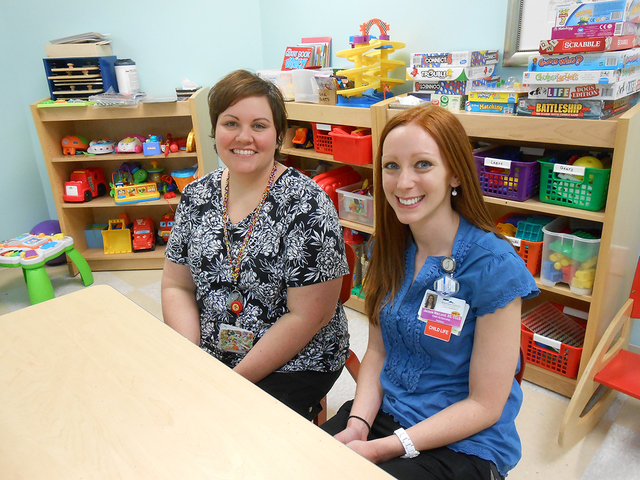Child life specialists help kids cope with hospital visits
Some children at Summerlin Hospital Medical Center call them by their first names. Others, the younger ones, will refer to them by other names, such as “Bubbles.”
“Because we blow bubbles together,” Jodi Miles said. “They remember that.”
Miles and her cohort, Jacquelyn MacLeod, are certified as child life specialists. They work with the child to help him understand this scary place called a hospital.
“Most people have never heard of a child life specialist,” MacLeod said. “One of my favorite things is hearing someone explain what we do to someone else. They’ll call me a patient advocate … I had one patient call me their cheerleader.”
Miles generally works the pediatrics ward on the fifth floor. It can handle 29 children at one time. She prioritizes her day by need — is a child having surgery or a major procedure such as a CAT scan? — which means some days, she cannot get to see every child. Her eight-hour day is one of constant interaction and sometimes necessitates a “working lunch.”
“If they’re going to have surgery, I take into consideration their age, and I talk to them about things they may be having some fears about,” Miles said. “Anything from having a picture taken (X-ray) to using dolls to help them better understand — so they know what’s happening.”
MacLeod works four 10-hour shifts spanning the afternoon to the evening. Those are the hours when a child will generally come into the emergency room. Issues can range from a sports injury to an ongoing condition.
“Kids come in after school, after families are done with work, and the urgent care is closed. The ER is unpredictable; you just take things as they come,” MacLeod said. “But I prioritize much the same way … If kids are going to be spending the night in the hospital, that can be very scary to them. So I use a lot of the same teaching techniques as Jodi. I just don’t have the luxury of knowing what’s coming before it’s already here.”
She is often meeting the patient even before the doctor sees him. Both use language the child can understand to explain the situation and procedures that need to be done.
“You want to paint an honest picture for the patient,” MacLeod said. “You don’t say, ‘It won’t hurt at all’ because that would break the trust. You use words that are age-appropriate, that are the least threatening. Like, if you have to set up an IV in a young child, you say, ‘It’s like having a plastic straw on your arm that helps you get a drink of water,’ and say, ‘I’m going to stick you with a needle, and you’ll feel a pinch when I put it on, but after that, the pinchy part will go away.’ You give them an accurate description of what’s going to happen.”
Miles said, “A lot of people think it’s a needle that’s left in your arm. It’s not. It’s just a tube.”
Nicole Hammond is at the hospital often with her 7-year-old, Taylor. He has a rare form of cancer, and his only hope for beating it is a stem cell transplant. They deal with Miles.
“She taught him about having his port accessed and created a medical doll for him to practice on to not be afraid,” Hammond said. “She also takes him on walks and does activities with him in the hospital playroom to help give my husband and I a break during our extended hospital stays.”
With all things being new to a child in the hospital, one of the more common questions they get is, “Why is this sticker on my finger?” It’s a pulse oximeter (a pulse-ox) that monitors one’s heart rate and breathing. “What’s going to happen?” or “Is it going to hurt?” are also common. Another oft-asked question: “When can I go home?”
And sometimes the questions come from an alarmed brother or sister. One asked how big a cut was needed to get a picture of the inside of his sibling’s belly. The sibling was going in for a CT scan.
While they are pros at not letting their concern for chronically ill children show, there are times when the women have been overwhelmed by emotion and have to deal with their own tears.
“But we have celebrations, too,” Miles said. “We celebrate birthdays, and over the holidays, Santa will come or superheroes, like Wonder Woman. She’s here monthly.”
What do they wish parents knew?
“That we’re not magic; we’re not, ‘We can make this child not cry’ people,” MacLeod said.
To reach Summerlin Area View reporter Jan Hogan, email jhogan@viewnews.com or call 702-387-2949.

















